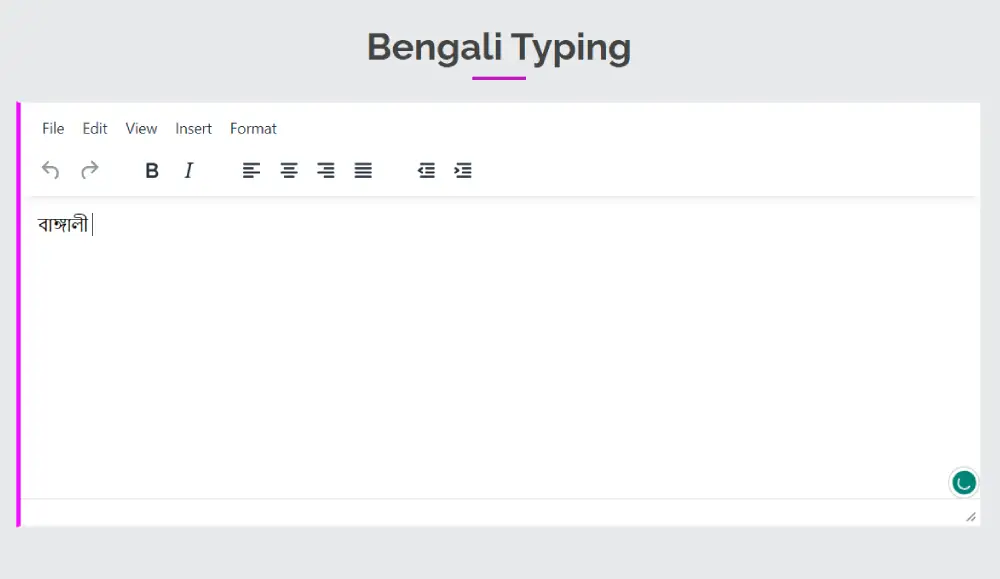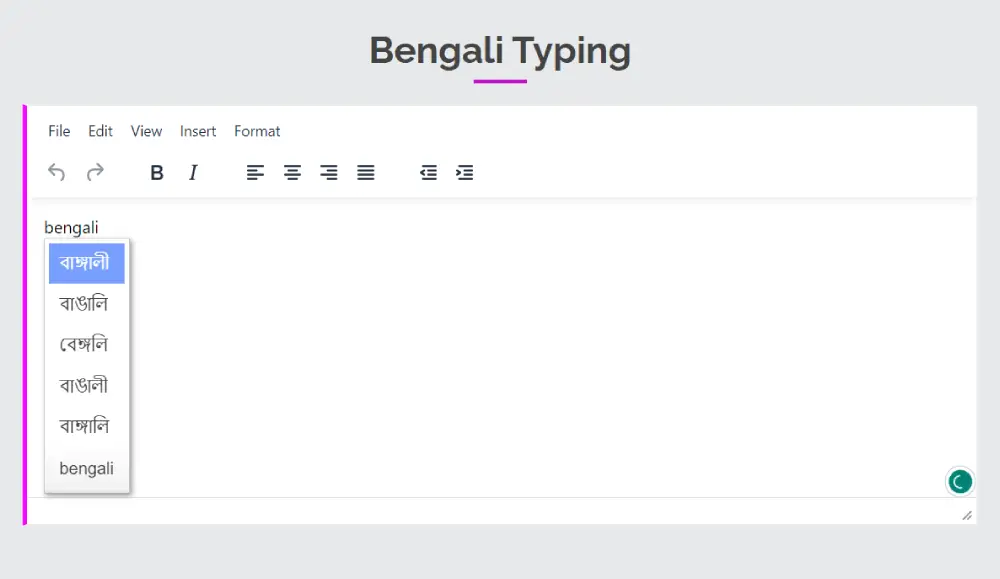Get Started with Our Bengali Typing Tool
Our Bengali typing tool makes it easy to type in Bengali without any technical knowledge or software downloads. All you need to do is visit our website and start typing! Our intuitive layout ensures that you`ll be able to quickly navigate the page and get started with your typing. Best of all, you don`t have to worry about accuracy - our tool will automatically detect and correct mistakes as you type! In mobile when you type in all the given text-area space, your content fills the text-area and if you want to increase the size of the text area, you can expand its size each time you press the button EXPAND and after completion and start a new content typing press the button SHRINK and the text area will be back to its original size. On the desktop, once the text has been typed into the desired language, all you need to do is select it all, press “ctrl-c,” copy it, and then press “ctrl-v” to paste it back into your document. When you are on mobile just simply click the COPY button and copy all your text and then paste it into your desired location. And also clear your text area after typing press the CLEAR button and you can type other contents as you like.
Unable to find the correct transliterate?


Bengali Language
Bengali is a language spoken in the Indian subcontinent, primarily in the eastern state of West Bengal and the neighboring country of Bangladesh. It is the seventh most spoken language in the world, with over 200 million speakers. Bengali is written in the Bengali script, which is a member of the Brahmic family of scripts. The language has a rich literary tradition, and is known for its contributions to poetry, drama, and film.
History of Bengali
Bengali has a long and rich history dating back to the 10th century. It evolved from the Magadhi Prakrit and Sanskrit languages, and was heavily influenced by Pali, the language of Buddhist scriptures. The earliest form of Bengali literature can be traced back to the 9th-10th centuries, with the Charyapada being one of the earliest examples. The language continued to develop over the centuries, and was further shaped by the influx of Persian and Arabic words during the Mughal period. Bengali was also the language of the Bengal Renaissance, a cultural and intellectual movement in the late 19th and early 20th centuries that played a major role in the development of Indian independence movement. Today, Bengali is the official language of the Indian state of West Bengal and the neighboring country of Bangladesh.
Bengali Script (বাংলা লিপি)
Consonants (ব্যঞ্জনবর্ণ)
ক (ka), খ (kha), গ (ga), ঘ (gha), ঙ (nga), চ (ca), ছ (cha), জ (ja), ঝ (jha), ঞ (ña), ট (tʰa), ঠ (tʰha), ড (d̪a), ঢ (d̪ha), ণ (ña), ত (ta), থ (tha), দ (da), ধ (dha), ন (na), প (pa), ফ (pha), ব (ba), ভ (bha), ম (ma), য (ya), র (ra), ল (la), শ (śa), ষ (ṣa), স (sa), হ (ha), ক্ষ (kṣa), ত্র (tra), জ্ঞ (gya), ঙ্ক (ŋka), ঞ্জ (ñja), ঞ্ছ (ñcʰa)
Vowels (স্বরধ্বনি)
অ (a), আ (aa), ই (i), ঈ (ii), উ (u), ঊ (uu), এ (e), ঐ (oi), ও (o), ঔ (ou), ঋ (ri)
Numbers (সংখ্যা)
১ (one), ২ (two), ৩ (three), ৪ (four), ৫ (five), ৬ (six), ৭ (seven), ৮ (eight), ৯ (nine), ১০ (ten)
Transliterate English to Bengali
Our online typing system will allow you to transliterate English into Bengali. We use the Google transliterate feature to translate, which is very fast and accurate. You can simply convert each word, just press the space bar after typing them. Also, you can get a choice option dropdown if you press the back key. You can edit your text with a text editor to bold, italic etc. Format and style all your converted Bengali content. We use some autocorrection features to transliterate your broken words without retyping them. Which saves you more time in typing.
Press (Ctrl+G) to switch between English and Bengali. Also, you can save them as txt or doc for your further use.
Translate vs Transliterate
Translation refers to the process of converting written text from one language to another while preserving the meaning of the original text. Translation involves converting the words and phrases of a text from one language to their equivalents in another language, taking into account the context and cultural differences between the languages.
Transliteration, on the other hand, refers to the process of converting written text from one script (alphabet or writing system) to another, while preserving the sounds of the original text. Transliteration involves converting the letters and characters of a text from one script to their equivalents in another script, without necessarily preserving the meanings of the words.
For instance, the Spanish equivalent of the English phrase "Hello, how are you?" is "Hola, cómo estás?" This translation keeps the original phrase`s meaning. On the other hand, the English phrase "Hello, how are you?" can be transliterated into the Greek alphabet as "Χαίρετε, πώς είσαι;", which preserves the sounds of the original phrase but not necessarily it`s meaning.
Translation and transliteration are both useful tools for helping people communicate and understand written text in different languages and scripts. However, they serve different purposes and involve different approaches to converting written text.
